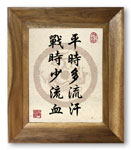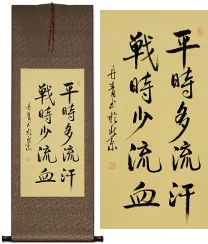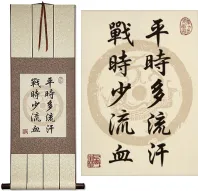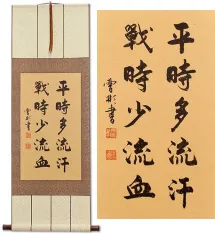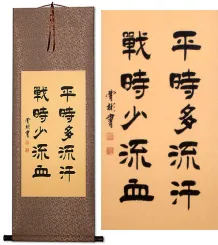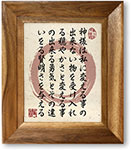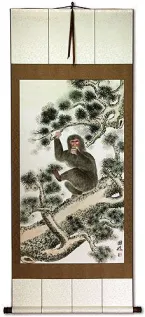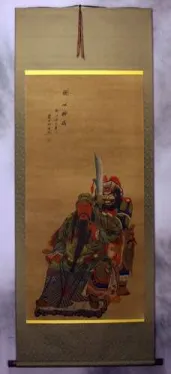Many custom options...
And formats...

Not what you want?
Try other similar-meaning words, fewer words, or just one word.
Feel free to email me with your request. If it's easy, I'll translate it for free and add it to this database of calligraphy for you.
We Are in Pain in Chinese / Japanese...
Buy a We Are in Pain calligraphy wall scroll here!
Personalize your custom “We Are in Pain” project by clicking the button next to your favorite “We Are in Pain” title below...
Pain is Weakness Leaving the Body
I remember this being shouted a lot during U.S. Marine Corps boot camp. 疼痛就是衰弱離你而去的時候 is how to write that phrase in Chinese. At least, this is as close as we could compose/translate it, and hold the full original meaning and connotations.
The version shown here is really, “Pain is weakness leaving your body.” Although it's said in English both ways (the or your), it works better in Chinese with “your.”
Contentment
知足 means content with one's situation or to know contentment (hence happiness).
From the Zen Buddhist context, Chisoku or 知足 (knowing what’s enough) means always to know and be
satisfied with one’s lot.
Human pain and suffering are born of greed, and that greed arises because we do not know what’s enough.
The Chinese philosopher, Menzi (372-289 BCE) said, “to nourish the mind, there is nothing better than to make the desires few.”
This relays the idea that the best method to cultivate the mind is to have little desire.
This in-stock artwork might be what you are looking for, and ships right away...
Starting at: $19.88
Gallery Price: $120.00
Your Price: $61.88
Gallery Price: $120.00
Your Price: $61.88
Gallery Price: $90.00
Your Price: $49.88
Gallery Price: $220.00
Your Price: $112.88
Gallery Price: $220.00
Your Price: $99.88
Gallery Price: $60.00
Your Price: $36.88
Gallery Price: $61.00
Your Price: $33.88
Gallery Price: $108.00
Your Price: $59.88
Not the results for we are in pain that you were looking for?
Below are some entries from our dictionary that may match your we are in pain search...
| Characters If shown, 2nd row is Simp. Chinese |
Pronunciation Romanization |
Simple Dictionary Definition |
夏 see styles |
xià xia4 hsia natsu なつ |
More info & calligraphy: Summer Season(n,adv) summer; (female given name) Pain Summer. |
痛 see styles |
tòng tong4 t`ung tung tsuu / tsu つう |
More info & calligraphy: Pain(n-suf,n) pain; ache; -algia; (personal name) Ikarimoto pain |
四諦 四谛 see styles |
sì dì si4 di4 ssu ti shitai したい |
More info & calligraphy: Four Noble Truths (Buddhism){Buddh} (See 苦集滅道) The Four Noble Truths catvāri-ārya-satyāni; 四聖諦; 四眞諦. The four dogmas, or noble truths, the primary and fundamental doctrines of Śākyamuni, said to approximate to the form of medical diagnosis. They are pain or 'suffering, its cause, its ending, the way thereto; that existence is suffering, that human passion (taṇhā, 欲 desire) is the cause of continued suffering, that by the destruction of human passion existence may be brought to an end; that by a life of holiness the destruction of human passion may be attained'. Childers. The four are 苦, 聚 (or 集), 滅, and 道諦, i. e. duḥkha 豆佉, samudaya 三牟提耶, nirodha 尼棲陀, and mārga 末加. Eitel interprets them (1) 'that 'misery' is a necessary attribute of sentient existence'; (2) that 'the 'accumulation' of misery is caused by the passions'; (3) that 'the 'extinction' of passion is possible; (4) mārga is 'the doctrine of the 'path' that leads to the extinction of passion'. (1) 苦 suffering is the lot of the 六趣 six states of existence; (2) 集 is the aggregation (or exacerbation) of suffering by reason of the passions; (3) 滅 is nirvana, the extinction of desire and its consequences, and the leaving of the sufferings of mortality as void and extinct; (4) 道 is the way of such extinction, i. e. the 八正道 eightfold correct way. The first two are considered to be related to this life, the last two to 出世間 a life outside or apart from the world. The four are described as the fundamental doctrines first preached to his five former ascetic companions. Those who accepted these truths were in the stage of śrāvaka. There is much dispute as to the meaning of 滅 'extinction' as to whether it means extinction of suffering, of passion, or of existence. The Nirvana Sutra 18 says that whoever accepts the four dogmas will put an end to births and deaths 若能見四諦則得斷生死 which does not of necessity mean the termination of existence but that of continued transmigration. v. 滅. |
激烈 see styles |
jī liè ji1 lie4 chi lieh gekiretsu げきれつ |
More info & calligraphy: Fierce(noun or adjectival noun) violence; vehemence; fury; fervour; fervor; severity; fierceness; keenness |
無痛 无痛 see styles |
wú tòng wu2 tong4 wu t`ung wu tung mutsuu / mutsu むつう |
More info & calligraphy: Painless(noun - becomes adjective with の) painless |
ハイン see styles |
pain パイン |
More info & calligraphy: Hein |
恋の悩み see styles |
koinonayami こいのなやみ |
More info & calligraphy: The Pain of Love / Love Troubles |
愛別離苦 爱别离苦 see styles |
ài bié lí kǔ ai4 bie2 li2 ku3 ai pieh li k`u ai pieh li ku aibetsuriku あいべつりく |
More info & calligraphy: The Pain of Separation from Your Loves(yoji) {Buddh} the pain of separation from loved ones The suffering of being separated from those whom one loves. v. 八苦. |
苦は楽の種 see styles |
kuharakunotane くはらくのたね |
More info & calligraphy: There is no pleasure without pain |
慇 殷 see styles |
yīn yin1 yin in |
solicitous Anxious. |
捨 舍 see styles |
shě she3 she sha しゃ |
to give up; to abandon; to give alms {Buddh} equanimity; upeksa; upekkha upekṣā, neglect, indifference, abandoning, M.W. To relinquish, renounce, abandon, reject, give. One of the chief Buddhist virtues, that of renunciation, leading to a state of "indifference without pleasure or pain" (Keith), or independence of both. v. 舍. It is defined as the mind 平等 in equilibrium, i.e. above the distinction of things or persons, of self or others; indifferent, having abandoned the world and all things and having no affections or desires. One of the seven bodhyaṅgas. Translit. sa, śa, s(r). |
楚 see styles |
chǔ chu3 ch`u chu chiyu ちゆ |
distinct; clear; orderly; pain; suffering; deciduous bush used in Chinese medicine (genus Vitex); punishment cane (old) (1) (archaism) switch (long, tender shoot of a plant); (2) switch (cane used for flogging); (archaism) switch (flogging implement made from a branch); (place-name) Chu (name of several ancient Chinese states); Ch'u Brambles, spinous; painful, grievous; to flog; clear up; the Chu state. |
滅 灭 see styles |
miè mie4 mieh metsu |
to extinguish or put out; to go out (of a fire etc); to exterminate or wipe out; to drown Extinguish, exterminate, destroy; a tr. of nirodha, suppression, annihilation; of nirvāṇa, blown out, extinguished, dead, perfect rest, highest felicity, etc.; and of nivṛtti, cessation, disappearance. nirodha is the third of the four axioms: 苦, 集, 滅, 道 pain, its focussing, its cessation (or cure), the way of such cure. Various ideas are expressed as to the meaning of 滅, i.e. annihilation or extinction of existence; or of rebirth and mortal existence; or of the passions as the cause of pain; and it is the two latter views which generally prevail; cf. M017574 10 strokes. |
漏 see styles |
lòu lou4 lou ro |
to leak; to divulge; to leave out by mistake; waterclock or hourglass (old) āsrava, 'flowing, running, discharge; distress, pain, affliction.' M.W. It is defined as another term for 煩惱 q.v.; also as the discharge, or outflow, from the organs of sense, wherever those exist, hence it is applied to the passions and their filth; impure efflux from the mind, v. 欲有; also to the leakage or loss thereby of the 正道 truth; also to the stream of transmigration. |
痌 see styles |
tōng tong1 t`ung tung |
moaning in pain |
痾 疴 see styles |
kē ke1 k`o ko a |
(literary) disease; also pr. [e1] Sickness, pain; diarrhoea. |
苦 see styles |
kǔ ku3 k`u ku ku く |
bitter; hardship; pain; to suffer; to bring suffering to; painstakingly (1) pain; anguish; suffering; distress; anxiety; worry; trouble; difficulty; hardship; (2) {Buddh} (See 八苦) duhkha (suffering) duḥkha, 豆佉 bitterness; unhappiness, suffering, pain, distress, misery; difficulty. There are lists of two, three, four, five, eight, and ten categories; the two are internal, i. e. physical and mental, and external, i. e. attacks from without. The four are birth, growing old, illness, and death. The eight are these four along with the pain of parting from the loved, of meeting with the hated, of failure in one's aims, and that caused by the five skandhas; cf. 四諦. |
うん see styles |
un ウン |
(prefix noun) some (at the start of a number in place of a digit); (interjection) (1) yes; yeah; uh huh; (2) hum; hmmm; well; erm; (3) moan; groan; grunt (of pain); (female given name) Un |
三受 see styles |
sān shòu san1 shou4 san shou sanju |
The three states of Vedanā, i. e. sensation, are divided into painful, pleasurable, and freedom from both 苦, 樂, 捨. When things are opposed to desire, pain arises; when accordant, there is pleasure and a desire for their continuance; when neither, one is detached or free. 倶舍論 1. |
三苦 see styles |
sān kǔ san1 ku3 san k`u san ku sanku |
The three kinds of duḥkha, pain, or suffering: 苦苦 that produced by direct causes; 壞苦 by loss or deprivation; 行苦 by the passing or impermanency of all things. |
二受 see styles |
èr shòu er4 shou4 erh shou niju |
The dual receptivity or karma of pleasure and pain, the physical and the mental, i.e. 身 and 心. |
二因 see styles |
èr yīn er4 yin1 erh yin niin / nin にいん |
{Buddh} two causes Two causes, of which there are various definitions: (1) 生因 The producing cause (of all good things); and 了因 the revealing or illuminating cause i.e. knowledge, or wisdom. (2) 能生因 The 8th 識 q. v.: the cause that is able to produce all sense and perceptions, also all good and evil; and 方便因 the environmental or adaptive cause, which aids the 8th 識, as water or earth does the seed, etc. (3) 習因 or 同類因 Practice or habit as cause e. g. desire causing desire; and 報因 or 果熟因 the rewarding cause, or fruit-ripening cause, e. g. pleasure or pain caused by good or evil deeds. (4) 正因 Correct or direct cause i.e. the Buddha-nature of all beings; and 緣因 the contributory cause, or enlightenment (see 了因 above) which evolves the 正因 or Buddha-nature by good works. (5) 近因 Immediate or direct cause and 遠因 distant or indirect cause or causes. |
二果 see styles |
èr guǒ er4 guo3 erh kuo nika |
Sakṛdāgāmin; v. 裟 and 斯. The second "fruit" of the four kinds of Hīnayāna arhats, who have only once more to return to mortality. Also the two kinds of fruit or karma: (a) 習氣果 The good or evil characteristics resulting from habit or practice in a former existence; (b) 報果the pain or pleasure resulting (in this life) from the practices of a previous life. |
五受 see styles |
wǔ shòu wu3 shou4 wu shou goju |
The five vedanas, or sensations; i. e. of sorrow, ofjoy; of pain, of pleasure; of freedom from them all; the first two are limited to mental emotions, the two next are of the senses, and the fifth of both; v. 唯識論 5. |
五果 see styles |
wǔ guǒ wu3 guo3 wu kuo goka ごか |
(1) five fruits (peach, Japanese plum, apricot, jujube, Japanese chestnut); (2) (Buddhist term) five types of effect in cause-and-effect relationships; (3) (Buddhist term) five effects of ignorance and formations on one's current life The five fruits, or effects; there are various groups, e. g. I. (1) 異熟果 fruit ripening divergently, e. g. pleasure and goodness are in different categories; present organs accord in pain or pleasure with their past good or evil deeds; (2) 等流果 fruit of the same order, e. g. goodness reborn from previous goodness; (3) 土用果 present position and function fruit, the rewards of moral merit in previous lives; (4) 增上果 superior fruit, or position arising from previous earnest endeavor and superior capacity: (5) 離繋果 fruit of freedom from all bonds, nirvana fruit. II. Fruit, or rebirth: (1) 識 conception (viewed psychologically); (2) 名色 formation mental and physical; (3) 六處 the six organs of perception complete; (4) 觸 their birth and contact with the world; (5) 受 consciousness. III. Five orders of fruit, with stones, pips, shells (as nuts), chaff-like (as pine seeds), and with pods. |
五痛 see styles |
wǔ tòng wu3 tong4 wu t`ung wu tung gotsū |
idem 五燒. |
五識 五识 see styles |
wǔ shì wu3 shi4 wu shih goshiki |
The five parijñānas, perceptions or cognitions; ordinarily those arising from the five senses, i. e. of form-and-color, sound, smell, taste, and touch. The 起信論 Awakening of Faith has a different set of five steps in the history of cognition; (1) 業識 initial functioning of mind under the influence of the original 無明 unenlightenment or state of ignorance; (2) 轉識 the act of turning towards the apparent object for its observation; (3) 現識 observation of the object as it appears; (4) 知識 the deductions derived from its appearance; (5) 相續識 the consequent feelings of like or dislike, pleasure or pain, from which arise the delusions and incarnations. |
傷み see styles |
itami いたみ |
(1) pain; ache; soreness; grief; distress; (2) damage; injury; wear; bruise; break |
傷む see styles |
itamu いたむ |
(v5m,vi) (1) to hurt; to ache; to feel a pain; (2) to be injured; to be spoiled (e.g. food); to be damaged |
傷嘆 see styles |
shoutan / shotan しょうたん |
crying in pain |
Click here for more we are in pain results from our dictionary
The following table may be helpful for those studying Chinese or Japanese...
| Title | Characters | Romaji (Romanized Japanese) | Various forms of Romanized Chinese | |
| Pain is Weakness Leaving the Body | 疼痛就是衰弱離你而去的時候 疼痛就是衰弱离你而去的时候 | téng tòng jiù shì shuāi ruò lí nǐ ér qù de shí hòu teng2 tong4 jiu4 shi4 shuai1 ruo4 li2 ni3 er2 qu4 de shi2 hou4 teng tong jiu shi shuai ruo li ni er qu de shi hou | t`eng t`ung chiu shih shuai jo li ni erh ch`ü te shih hou teng tung chiu shih shuai jo li ni erh chü te shih hou |
|
| Contentment | 知足 | chisoku | zhī zú / zhi1 zu2 / zhi zu / zhizu | chih tsu / chihtsu |
| In some entries above you will see that characters have different versions above and below a line. In these cases, the characters above the line are Traditional Chinese, while the ones below are Simplified Chinese. | ||||
Successful Chinese Character and Japanese Kanji calligraphy searches within the last few hours...


